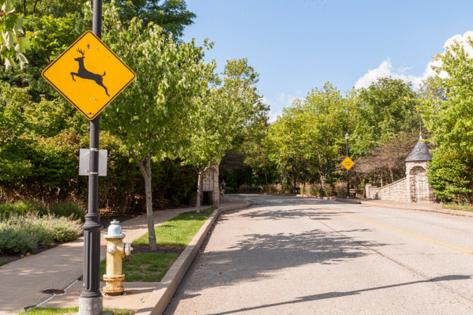'An uphill battle': With deer overpopulation in Pennsylvania's Allegheny County, Ross Township considers sharpshooters
Published in Outdoors
PITTSBURGH — While door-to-door campaigning in 2019, Dan DeMarco, president of the Ross Board of Commissioners, had several residents ask, "What are you going to do about the deer?"
Six years later, after the Board banned residents from feeding white-tailed deer and rolled out managed archery hunts, he said, there are still too many deer.
"If we could get into more private properties, that would be helpful. We get the word out to the residents — if you are willing, [Suburban Whitetail Management] can send a hunter. I can't think beyond that of anything else we can do."
The township is exploring a sharpshooter program to cull the deer herd at night in select locations, he said.
The city of Pittsburgh initiated its first sharpshooter program this year, conducted at night when parks are closed. Mt. Lebanon has a similar program.
Even with such initiatives, deer overpopulation remains a stubborn problem in Allegheny County.
In another abatement effort, the Pennsylvania Game Commission will increase antlerless licenses for the 2025-26 hunting season from 53,000 to 59,000 deer licenses for Wildlife Management Unit 2B, which includes mostly Allegheny County and slivers of several neighboring counties.
At 22,300 deer, the harvest in 2B for the 2024-25 hunting season was 3% lower than the previous year's.
That's not the case statewide, as Pennsylvania hunters harvested 11% more year over year, from an estimated 430,010 deer in 2023-24 to 476,880 in 2024-25.
Although one year of statistics does not make a trend, other factors assessed by the Ross Commission over multiple years point to a growing deer population in Allegheny County.
Difficulties with urban deer herds
City and suburban herds, like the ones in Allegheny County, are likely the most difficult to manage with traditional hunting, said Jeannine Fleegle, a wildlife biologist in the Game Commission's Deer & Elk section.
"It has worked wonderfully for many years. But now the problem is deer can adapt to live almost anywhere in suburban and urban situations where we have created our lives."
Hunting is difficult in densely populated areas in part because of the 50-yard safety zone from homes and occupied buildings required for archery hunting.
Managed hunts can be planned for some parcels, but landowners and sometimes municipalities must agree.
"Either the hunter has to do the legwork to get permission or the township or some community entity needs to take on that burden of clearing the way so hunters can come into the community," Fleegle said.
There are managed archery hunts throughout the state including in Ross and, more recently, city parks.
For the deer overpopulation problem in the 2B region, Fleegle said each community is different and a one-size-fits-all approach doesn't work.
"It's never a one-action solution," she said. "If you're building a house, you don't just need a hammer, you need a lot of tools.
"We empathize and are trying to find solutions working with communities." Managed hunts with archers and sharpshooters are one solution. Banning the feeding of deer is another.
Future options can include fertility control, which can be effective in select circumstances, she said.
Humane World for Animals (formerly the Humane Society) has been working on fertility options; however, there are limitations, such as needing to handle individual deer, Fleegle said. Currently, there is no broad-spectrum approach.
"If you were to do some sort of oral contraceptive, deer are not like humans who ovulate every month," she said "They only breed once a year and timing matters."
Deer issues in Ross
In 2020, Ross began its managed archery hunts, contracting with Suburban Whitetail Management, on township properties (excluding parks) and private properties with consent from the owners. Currently, the program covers nine township-owned properties and eight private properties.
For the 2024-25 season, the managed hunt harvested 48 deer by 24 vetted archers.
"The archery hunts are helping a little bit. Based on the numbers of roadkill, there's still a population," DeMarco said.
A township contractor picks up between 10 to 15 roadkill deer every month, he noted.
Deer and automobile strikes are common in the region; Pennsylvania continues to lead the nation in animal collisions.
"We all recognize moving forward with the culling program that we still have an overpopulation of deer causing damage to property and cars," DeMarco said. "We need to do something to put a bigger dent in the deer population."
Results take years, Fleegle said. "You can't change the deer population on a dime."
DeMarco laments there is a misconception that the deer population problem is the township's fault and that it took away the animals' land.
While there is no denying the development in the township, DeMarco said, developments have been around for a long time. And the deer herds grew noticeably large in more recent years, he said.
One problem is the adaptability of deer to live in urban and suburban areas, Fleegle said.
The herds are also increasing because of the absence of apex predators like wolves, although coyotes will take fawns, DeMarco said.
Without predators and with plenty of food, deer populations can double every two years, according to wildlife agencies.
"They keep on multiplying and we're trying to control it," he said, "but we are having an uphill battle."
© 2025 the Pittsburgh Post-Gazette. Visit www.post-gazette.com. Distributed by Tribune Content Agency, LLC.







Comments